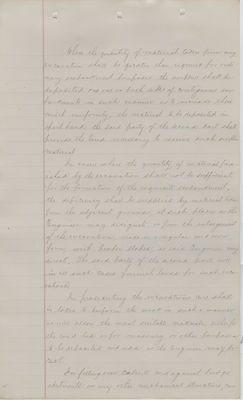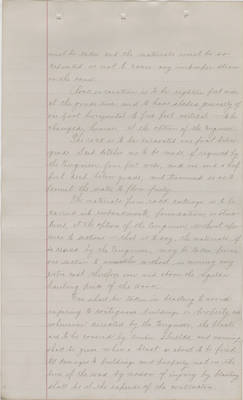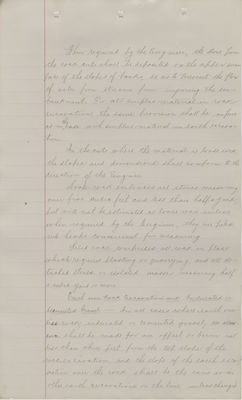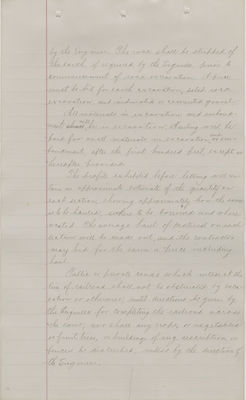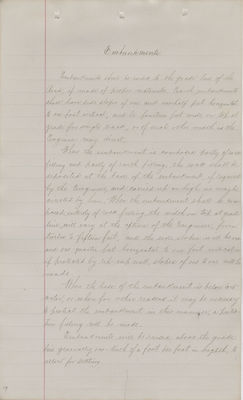Pages
Robinson_09051867__0376
Where the quantity of material taken from any excavation shall be greater than required for ordi= nary embankment purposes the surplus shall be deposited on one or both sides of contiguous em= bankments in such manner as to increase their width uniformly, the material to be deposited in spoil bank, the said party of the second part shall provide the land necessary to receive such surplus material.
In cases where the quantity of material furn= ished by the excavation shall not be sufficient for the formation of the requisite embankment, the deficiency shall be supplied by material taken from the adjacent grounds, at such places as the Engineer may designate, or from the enlargement of the excavation, made in a regular and even form, with proper slopes, as said Engineer may direct. The said party of the second part will in all such cases furnish lands for such exca= vations.
In prosecuting the excavations care shall be taken to perform the work in such a manner as will allow the most suitable materials, either for the road-bed or for masonry or other purposes, to be deposited and used as the Engineer may di= rect.
In filling over culverts and against bridge abutments or any other mechanical structure, care
[bottom left margin:] 15
Robinson_09051867__0377
must be taken and the materials must be so deposited as not to cause any improper strain on the same.
Rock excavation is to be eighteen feet wide at the grade line, and to have slopes generally of one foot horizontal to five feet vertical — to be changed, however, at the option of the Engineer.
The rock is to be excavated one foot below grade. Said ditches are to be made, if required by the Engineer, four feet wide, and one and a half feet deep below grade, and trimmed so as to permit the water to flow freely.
The materials from rock cuttings is to be carried into embankments, foundations, or stru= tures, at the option of the Engineer without refer= ence to sections — that is to say, the materials, if so desired by the Engineer, may be taken frome[from] one section to another without incurring any extra cost therefore, over and above the regular hauling price of the work.
Care shall be taken in blasting to avoid injuring to contiguous buildings or property, and whenever directed by the Engineer, the blasts are to be covered by timber shields, and warning shall be given when a blast is about to be fired. All damages to buildings and property not on the line of the road by reason of injury by blasting, shall be at the expense of the contractors.
[bottom left margin:] 16
Robinson_09051867__0378
When required by the Engineer, the stone from the rock cuts shall be deposited on the upper sur= face of the slopes of banks, so as to prevent the flow of water from streams from injuring the em= bankment. Fore all surplus material in rock excavation, the same provision shall be in force as in [caret]the case with surplus material in earth excava= tion.
In the cuts where the material is loose rock, the slopes and dimensions shall conform to the directions of the Engineer.
Loose rock embraces all stones measuring over five cubic feet and less than half a yard, but will not be estimated as loose rock unless, when required by the Engineer, they are piled into heaps convenient for measuring.
Solid rock comprises all rock in place which requites blasting or quarrying, and all de= tached stones or isolated masses measuring half a cubic yard or more.
Earth[underlined] of "Rock Excavation and Indurated or Cemented Gravel."[underlined] — In all case where earth overlies rock, indurated or cemented gravel, an allow= ance shall be made for an offset or berm not less than three feet from the top slope of the rock excavation, and the slope of the earth exca= vation over the rock shall be the same as in other earth excavation on the line, unless changed
[bottom left margin:] 17
Robinson_09051867__0379
by the Engineer. The rock shall be stripped of the earth, if required by the Engineer, prior to commencement of rock excavation. A price must be bid for earth excavation, solid rock excavation, and indurated or cemented gravel.
All materials in excavation and embank= ment "shall"[crossed out] [caret]"will" be in excavation. Hauling will be paid for on all materials in excavation [caret}"and" "or"[crossed out] em= bankment, after the first hundred feet, except as hereafter provided.
The profile exhibited before letting will con= tain an approximate estimate of the quantity on each section, showing approximately how the same is to be hauled, where to be borrowed and where wasted. The average haul of material on each section will be made out, and the contractor may bid for the same a price including haul.
Public or private roads which intersect the line of railroad shall not be obstructed by exca= vation or otherwise, until directions be given by the Engineer for completing the railroad across the same; nor shall any crops, or vegetables or fruit trees, or buildings of any description, or fences be disturbed, unless by the direction of the Engineer.
[bottom left margin:] 18
Robinson_09051867__0380
Embankments[centered]
Embankments shall be raised to the grade line of the Road, if made of proper materials. Earth embankments shall have side slopes of one and one-half feet horizontal to one foot vertical, and be fourteen feet wide on top at grade for single tracks, or of such other width as the Engineer may direct.
When the embankment is composed partly of rock filling and partly of earth filling, the rock shall be deposited at the base of the embankment, if required by the Engineer, and carried up as high as may be directed by him. When the embankment shall be com= posed entirely of rock filling, the width on top at grade line will vary at the option of the Engineer, from twelve to fifteen feet, and the side slopes will be one and one-quarter feet horizontal to one foot vertical, or if protected by rip-rap wall, slopes of one to one will be made.
When the base of the embankment is below low water, or where for other reasons it may be necessary to protect the embankment in this manner, a protec= tion filling will be made.
Embankments will be raised above the grade line generally on-tenth of a foot per foot in highth, to allow for settling.
[bottom left margin:] 19
